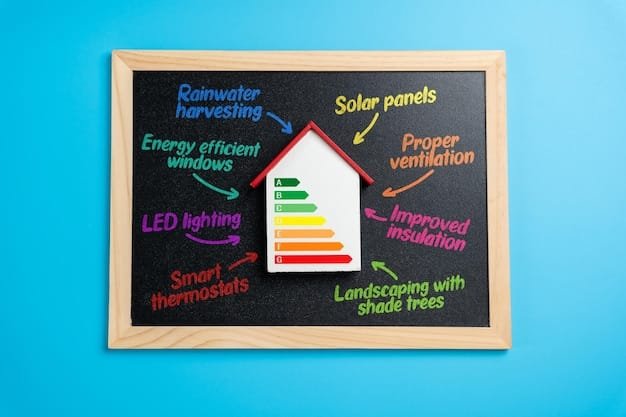Energy-Saving Tips: Lower Utility Bills and Save $100+ Monthly

Energy-saving tips can significantly lower your utility bills and help you save over $100 per month by implementing simple changes, upgrading appliances, and improving your home’s insulation to reduce energy consumption.
Are you looking for ways to reduce your monthly expenses? Learning effective energy-saving tips can dramatically lower your utility bills, potentially saving you over $100 each month.
Understanding Your Energy Consumption
Before diving into specific tips, it’s crucial to understand where your energy is being used. This knowledge allows you to focus on the areas where you can make the biggest impact on your utility bills.
Conducting an Energy Audit
An energy audit helps identify energy inefficiencies in your home. You can hire a professional or perform a DIY audit.
Analyzing Your Utility Bills
Reviewing your past utility bills can reveal trends and spikes in energy usage. Look for patterns related to seasons or specific activities.
- Identify peak usage times.
- Compare monthly bills to spot anomalies.
- Check for any unusual charges or fees.

By understanding your energy consumption, you can tailor your energy-saving strategies to address your home’s unique needs. Addressing these inefficiencies is key to saving money.
Simple Changes, Big Savings
Sometimes, the smallest changes can lead to significant savings on your utility bills. These adjustments require minimal effort but can have a noticeable impact.
Switching to LED Lighting
LED bulbs use significantly less energy than traditional incandescent bulbs, last much longer, and produce less heat.
Unplugging Electronics
Many electronics consume energy even when turned off, a phenomenon known as “phantom load” or “vampire power.”
- Unplug chargers when not in use.
- Use power strips to easily turn off multiple devices.
- Turn off computers and monitors when not actively working.
By implementing these simple changes, you can reduce your energy consumption without sacrificing comfort or convenience. These steps are easy to integrate into your daily routine.

Smart Thermostat Control
Heating and cooling account for a large portion of your energy bill. Using a smart thermostat can help you manage your energy usage efficiently.
Programmable Thermostats
Programmable thermostats allow you to set different temperatures for various times of the day. This ensures you’re not wasting energy heating or cooling an empty home.
Smart Thermostat Features
Smart thermostats offer advanced features like remote control, learning capabilities, and integration with smart home systems.
- Adjust the temperature remotely via smartphone.
- Set schedules based on your daily routine.
- Use geofencing to adjust the temperature automatically when you leave or approach home.
Smart thermostats provide convenience and significant energy savings by optimizing your heating and cooling schedules. They adapt to your lifestyle and preferences.
Upgrade to Energy-Efficient Appliances
Old and inefficient appliances can be major energy hogs. Upgrading to energy-efficient models can save you money in the long run.
Energy Star Appliances
Look for the Energy Star label when purchasing new appliances. These products meet strict energy efficiency guidelines set by the EPA.
Rebates and Incentives
Many utility companies offer rebates and incentives for purchasing Energy Star appliances. Check with your local providers for available programs.
Investing in energy-efficient appliances is an effective way to reduce your energy consumption and lower your utility bills. These upgrades often come with additional benefits like improved performance and longer lifespan.
Improve Your Home’s Insulation
Proper insulation is essential for maintaining a comfortable home temperature and reducing energy waste. It prevents heat from escaping in the winter and entering in the summer.
Insulating Attics
Attics are often the biggest source of heat loss in a home. Adding insulation to your attic can significantly reduce your heating and cooling costs.
Sealing Windows and Doors
Drafts around windows and doors can let in cold air in the winter and hot air in the summer. Sealing these gaps can improve your home’s energy efficiency.
- Caulk around window and door frames.
- Use weather stripping to seal gaps.
- Consider installing storm windows.
Improving your home’s insulation is a long-term investment that can yield substantial energy savings. It enhances your home’s comfort and reduces your reliance on heating and cooling systems.
Water Heating Efficiency
Water heating is another significant energy expense. There are several ways to reduce the energy used to heat water in your home.
Low-Flow Showerheads and Faucets
Low-flow showerheads and faucets reduce the amount of water used without sacrificing water pressure. This conserves both water and the energy needed to heat it.
Insulating Your Water Heater
Insulating your water heater can prevent heat loss and reduce the amount of energy needed to maintain the water temperature.
- Wrap your water heater with an insulation blanket.
- Set the water heater temperature to 120°F (49°C).
- Fix any leaky faucets promptly.
By implementing these water heating efficiency tips, you can significantly reduce your energy consumption and lower your utility bills. These changes are cost-effective and easy to implement.
| Key Action | Brief Description |
|---|---|
| 💡 LED Lighting | Switch to LED bulbs for significant energy savings . |
| 🔌 Unplug Devices | Reduce standby power consumption by unplugging unused electronics. |
| 🌡️ Smart Thermostat | Use a smart thermostat to efficiently manage heating and cooling. |
| 🚿 Low-Flow Fixtures | Install low-flow showerheads and faucets to conserve water and energy. |
Frequently Asked Questions (FAQ)
▼
Start by switching to LED bulbs, unplugging electronics when not in use, and adjusting your thermostat settings. These simple changes can lead to immediate savings.
▼
Phantom load is the energy consumed by electronics when they are turned off but still plugged in. Unplug these devices or use power strips to cut off the power supply completely.
▼
Yes, smart thermostats can significantly reduce your heating and cooling costs by automatically adjusting the temperature based on your schedule and preferences.
▼
Proper insulation is crucial for maintaining a stable temperature in your home. It reduces the amount of energy needed for heating and cooling, saving you money.
▼
Energy Star appliances are certified to meet strict energy efficiency guidelines set by the EPA. They consume less energy than standard models, helping you save on utility bills.
Conclusion
Implementing these energy-saving tips can significantly lower your utility bills and help you save money each month. By understanding your energy consumption, making simple changes, and investing in energy-efficient upgrades, you can create a more sustainable and cost-effective home.





